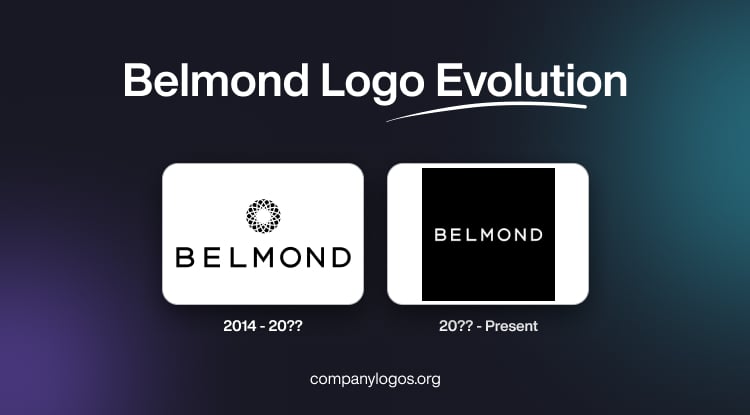
Belmond is a global luxury hospitality brand renowned for its collection of iconic hotels, trains, river cruises, and safari lodges. Based in London, UK, the company began its journey in 1976 as a provider of luxury rail travel. The company holds a strong presence in Europe and both North and South Americas. Belmond owns a few subsidiaries that are reputed as well. These include the Belmond Hotel Cipriani in Venice, Hotel Splendido in Portofino, and the Belmond Andean Explorer train in Peru. At present, Belmond is owned by the luxury goods brand, LVMH Moët Hennessy Louis Vuitton.
The Belmond logo has evolved over time in tandem with its strategic transformations and expansion into new markets. The logo encapsulates the brand’s philosophy, heritage, and its vision for the future of luxury travel. The article explores the evolution of the Belmond logo, among other details of the company.
The Genesis of the Belmond Logo (2014 – 20??)
In 2014, Belmond was rebranded from Orient-Express Hotels Ltd. The initial Belmond logo featured a graphical emblem and the brand name below. The graphical emblem conveyed sophistication and timelessness and consisted of a thick black circular ring woven with circular white patterns. The wordmark below was rendered in black uppercase using a sans-serif typeface. This modern, clean, and sophisticated logo reflected the brand’s ambition to appeal to a new generation of luxury travellers.

(20?? – Present)
The current logo stands as a symbol of modern luxury rooted in heritage. It is characterised by a minimalist, elegant wordmark in uppercase monochrome (black-and-white) using a sans-serif typeface. Interestingly, it does not have any graphical emblem, unlike its predecessor.

The Elements of the Belmond Logo
Font
The Belmond logo features a minimalist, elegant wordmark that reflects the brand’s commitment to sophistication and timeless luxury. The official typeface used in the Belmond logo is a custom-designed sans-serif font, which is clean, modern, and highly legible. This font was chosen to convey a sense of understated elegance and contemporary appeal. Further, it aligned with Belmond’s identity as a curator of refined travel experiences.
Colour
The primary colour of the Belmond logo is black, which underscores the brand’s values of luxury, sophistication, and timelessness. The use of pure black ensures maximum contrast and versatility across both digital and print applications.
The History of Belmond
The story of Belmond began in 1976 when American entrepreneur James Sherwood acquired the legendary Hotel Cipriani in Venice, Italy. This acquisition marked the foundation of what would become a global luxury hospitality brand. In fact, Sherwood’s vision extended beyond hotels. He purchased and restored original carriages from the famed Orient Express train and launched luxury train journeys between London, Paris, and Venice.
Throughout the 1980s and 1990s, the company, which was originally known as Orient-Express Hotels Ltd, expanded its portfolio. It included iconic hotels, trains, and river cruises across Europe, Africa, Asia, and the Americas.
In 1982, it launched the Venice Simplon-Orient-Express, which is a luxury train service connecting London, Paris, and Venice. It later expanded to Istanbul and other cities. In 1989, Belmond acquired the Copacabana Palace in Rio de Janeiro, Brazil. Also, between the 1990s and 2000s, the company added historic hideaways, beach resorts, and urban icons, such as Mount Nelson in Cape Town and Le Manoir aux Quat’Saisons in Oxfordshire.
In 2014, the company changed its name from Orient-Express Hotels Ltd to Belmond. In doing so, it sought a unique and wholly owned identity to unify its diverse global portfolio under a single master brand. The new name combined the French words for “beautiful” (bel) and “world” (monde) and signified a fresh era of elegance and adventure.
Belmond continued to expand and added properties in Mexico, Italy, and other destinations. It also invested in the restoration of legendary trains and hotels. In December 2018, luxury group LVMH (Moët Hennessy Louis Vuitton) announced the acquisition of Belmond in a $3.2 billion deal, which was completed in April 2019. This move positioned Belmond within LVMH’s portfolio of prestigious brands and accelerated its global growth and innovation.
Today, Belmond operates a curated collection of more than 44 properties, which include hotels, trains, river cruises, and safari lodges across more than 25 countries. The brand is recognised as a pioneer of “slow luxury” to emphasise immersive, authentic travel experiences that celebrate local culture, heritage, and the art of living well. The recent initiatives of Belmond include the restoration of iconic trains, such as the Venice Simplon-Orient-Express, and the launch of new luxury experiences in partnership with artists and designers.
Interesting Facts About Belmond
- Belmond began its journey with the acquisition of the legendary Hotel Cipriani in Venice, Italy, by entrepreneur James Sherwood.
- Since 1982, Belmond has operated the iconic Venice Simplon-Orient-Express. It revived the golden age of luxury train travel and connected London, Paris, and Venice.
- Belmond’s collection spans 44–47 properties (the exact number varies by source and recent acquisitions) across 25–28 countries. These include hotels, luxury trains, river cruises, and safari lodges.
- The brand owns and operates legendary properties such as Copacabana Palace in Rio de Janeiro, Le Manoir aux Quat’Saisons in Oxfordshire, and Villa San Michele in Florence.
- Some Belmond properties are located at the doorstep of UNESCO World Heritage Sites, such as Hotel das Cataratas in Brazil’s Iguassu National Park.
- Belmond frequently collaborates with renowned chefs, designers, and artists. These include recent partnerships with Dior for spa experiences and Wes Anderson and JR for train carriage designs.
- Belmond is a pioneer of “slow travel” or “slow luxury”. It encourages guests to savour time, immerse themselves in local culture, and connect deeply with destinations.
- Belmond was the first hospitality brand to win British Luxury Brand of the Year at the Walpole Awards. It marked its recognition beyond the travel sector to the wider luxury industry.
- The company aims to make a positive contribution to the destinations it operates in. It works closely with local communities and focuses on sustainable practices.
- Since 2019, Belmond has been part of LVMH (Moët Hennessy Louis Vuitton), which is a leading luxury group. This has accelerated its global growth and innovation.
- Belmond continues to expand, with recent acquisitions and renovations in Italy and Mexico and new hotel projects on the horizon.
- The brand has launched unique experiences such as the Dior Spa on the Royal Scotsman train and a sleeper carriage for the Venice Simplon-Orient-Express designed by French street artist JR.
- Belmond sees itself as a custodian of several properties. It blends history and craftsmanship with modern luxury to create lasting legacies.
- Each property reflects the cultural essence and aesthetic materials native to its location.
Finally
The Belmond logo shows the current status of the company as a global curator of luxury experiences. Through strategic rebranding, thoughtful design, and a deep respect for heritage, Belmond has crafted a visual identity that resonates with discerning travellers worldwide. The logo remains an enduring symbol of elegance, adventure, and the art of living well.